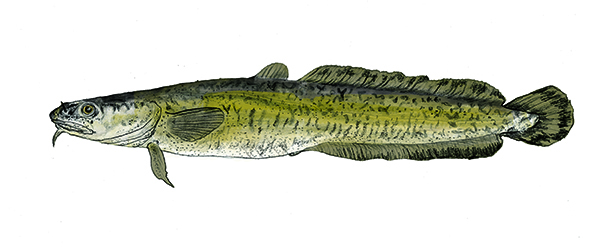Home → Fish & Wildlife → Fisheries → Species Information → Cusk
Cusk

Common Name: Cusk
Other Names: Burbot, Lawyer Fish (Great Lake states), Freshwater Cod
Scientific Name: Lota lota
Origin: Native
Adult Size: Sexual maturity is usually attained during the third or fourth year. Males often mature at a smaller size than females. Aged (otoliths) Maine cusk average 18 inches and 24 ounces in their eight year of growth, 20 inches and 32 ounces in their tenth year, and 24 inches and 62 ounces in their thirteenth year. The largest angler-caught cusk recorded in Maine was 18 pounds 8 ounces.
Adult Size: Sexual maturity is usually attained during the third or fourth year. Males often mature at a smaller size than females. Aged (via otoliths) Maine cusk average 18 inches and 24 ounces in their eight year of growth, 20 inches and 32 ounces in their tenth year, and 24 inches and 62 ounces in their thirteenth year. The largest angler-caught cusk recorded in Maine was 18 pounds 8 ounces.
Identification: Cusk have an elongated body with a broad, flattened triangular head. The mouth is large and wide. A single chin barbel adorns the lower jaw. Scales are small and embedded giving burbot the appearance of being slimy. The anal and dorsal fins run nearly half the length of the body. In Maine, coloration ranges from a tan to dark brown background overlaid with dark brown to black mottling or spots. Some may be uniformly dark brown or black.
Diet: Cusk are very opportunistic feeders. Food habit studies conducted on Moosehead Lake indicate that cusk feed heavily on smelts and crayfish. Other forage items consumed by cusk included various minnows, insects, invertebrates, and the remains of dead fish. Fish species commonly observed in cusk stomachs include sculpins, sticklebacks, yellow perch, and suckers.
Fishing Tips: Although occasionally taken during the open water season, cusk are readily caught during the winter ice fishing season. This coincides with the most active feeding period for the species. Mid-February to early March is a great time to target cusk in depths of 15 ft to 25 ft, with sandy/gravelly bottoms.
Because of their nocturnal feeding habits, fishing at night generally produces the best catches. Several Maine lakes provide locally popular night fisheries for cusk. Successful methods used while ice fishing include fishing with traps on or near bottom with live or dead bait. Jigging on or near bottom with artificial lures or dead bait is also effective. Cusk are also caught incidentally during the day when anglers are pursuing other coldwater sport fish, such as lake trout and lake whitefish.
Interesting Facts: Cusk spawning habits are unique, as they spawn during late winter under the ice. Cusk will spawn in pairs or in groups ranging from a dozen to even hundreds, in shallow water over sand or gravel bottoms. Eggs are broadcast over the substrate as no specific nests are built.
Cusk are relatively slow growing and are a long-lived species, attaining ages up to 20 years.
Management: Cusk are categorized as a non-sport fish and are not specifically managed for in Maine. There are no length, weight, or bag limit restrictions on cusk. As expressed by angler preference, the cusk is not highly regarded by Maine anglers. The results of MDIFW’s 2015 Maine Anglers’ Participation in and Opinions on Freshwater Fishing Survey, indicates that winter anglers “targeted” cusk behind all other coldwater species except the lake whitefish, and it ranked evenly with splake. Open water anglers “targeted” cusk behind all species except bullhead and lake whitefish in 2015.